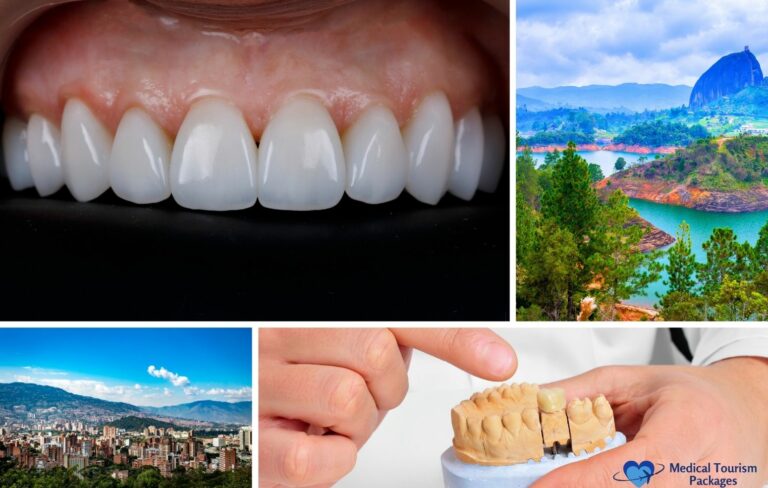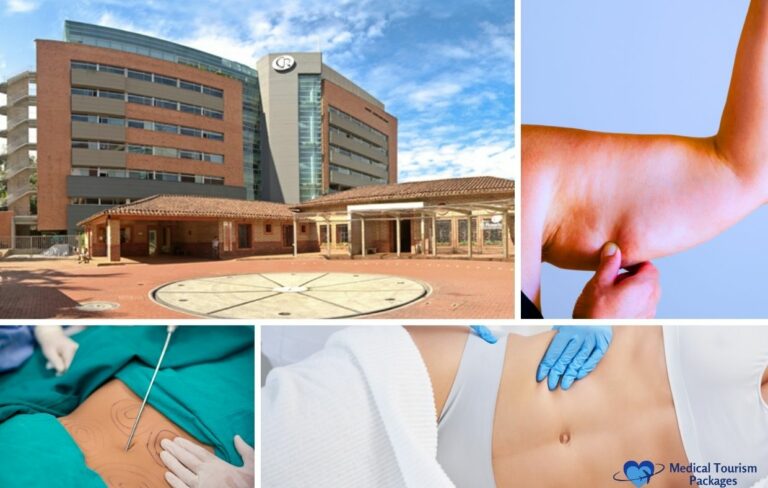Book Appointment Now
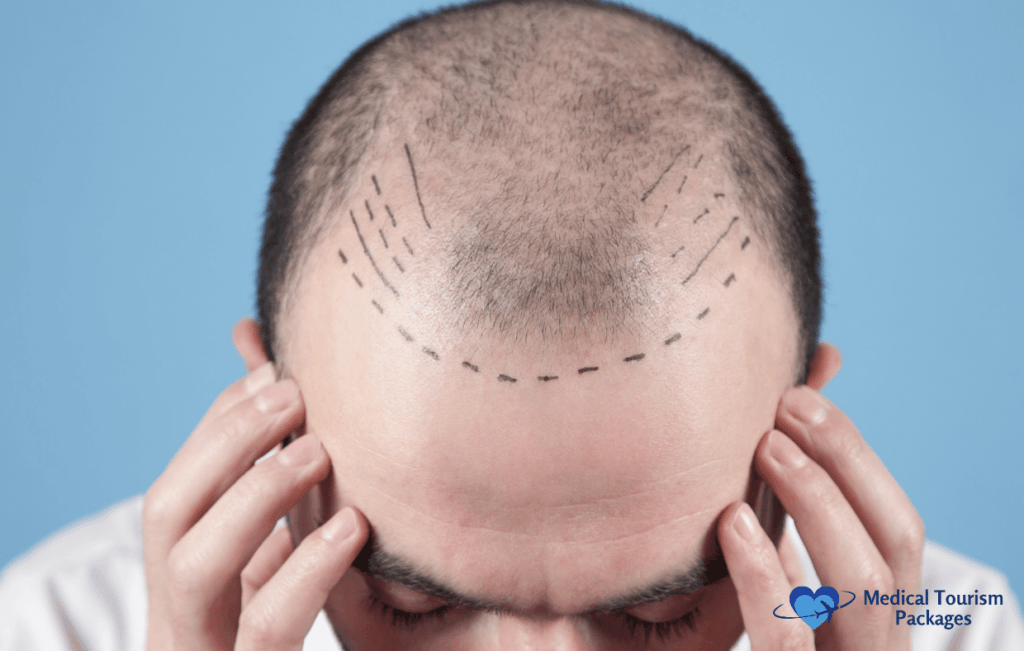
Hair Implants in Colombia: A Comprehensive Guide
Considering a solution for hair loss? Colombia might just be your go-to destination for hair implants, a procedure gaining traction for its blend of affordability and quality care. In this comprehensive guide, we’ll dive deep into what hair implants are, the innovative techniques used, and why Colombia has become a hotspot for those seeking to restore their locks.
From understanding the basics of hair transplant surgery to selecting the right surgeon and preparing for your journey, we’ve got you covered. Whether you’re curious about the benefits, the recovery process, or the cost, this article aims to equip you with all the necessary information to make an informed decision. Join us as we explore the world of hair implants in Colombia, a journey that could lead you to not just a fuller head of hair, but also renewed confidence and a chance to experience the vibrant culture of one of South America’s most beautiful countries.
What Are Hair Implants?
Hair implants, also known as hair transplants, are surgical procedures aimed at restoring hair growth in areas affected by baldness or thinning. The process involves transferring hair follicles from a donor site, usually the back or sides of the scalp, to the balding or thinning area. This technique not only enhances aesthetic appearance but also boosts self-confidence, addressing both cosmetic and psychological needs.
With advancements in medical technology, two primary methods have emerged: Follicular Unit Extraction (FUE) and Follicular Unit Transplantation (FUT). FUE involves individual follicle extraction, offering minimal scarring, while FUT involves removing a strip of skin with hair follicles to be transplanted.
Surgeries generally span between 4 and 8 hours, based upon the size of the transplant and the method employed. The outcome of a hair transplant is permanent; follicles extracted from regions unaffected by balding ensure sustained hair presence on the recipient site. FUE is notable for small incisions, absence of sutures, minimal discomfort, and swift healing. Patients opting for hair transplantation have long-lasting results with restoration of hair density, contributing to a more youthful and natural appearance.
What Are the Benefits of Hair Implant Surgery in Colombia?
Hair implant surgery offers significant benefits beyond mere aesthetic enhancement. Primarily, it serves as a permanent solution to hair loss, allowing individuals to regain a full head of hair. This procedure can dramatically improve one’s appearance, often leading to increased self-esteem and confidence.
Unlike temporary solutions or treatments that require ongoing maintenance, hair implants provide long-lasting results, with the transplanted hair growing naturally over time. Moreover, the advancements in techniques like Follicular Unit Extraction (FUE) and Follicular Unit Transplantation (FUT) have made the procedure less invasive, with shorter recovery times and minimal scarring, making it an appealing option for many. In the context of medical tourism in Colombia, patients not only benefit from the high-quality care and expertise of surgeons but also enjoy the cost-effectiveness of the procedures compared to those in other countries.
Aesthetic Enhancements
Hair implant surgery significantly improves the visual aspect of one’s appearance by filling in balding or thinning areas with natural, growing hair. This transformation leads to a more youthful and healthier look, aligning one’s external image with their internal vitality. The use of advanced techniques ensures that these enhancements look natural and seamless, effectively blending with the existing hair to create a fuller head of hair.
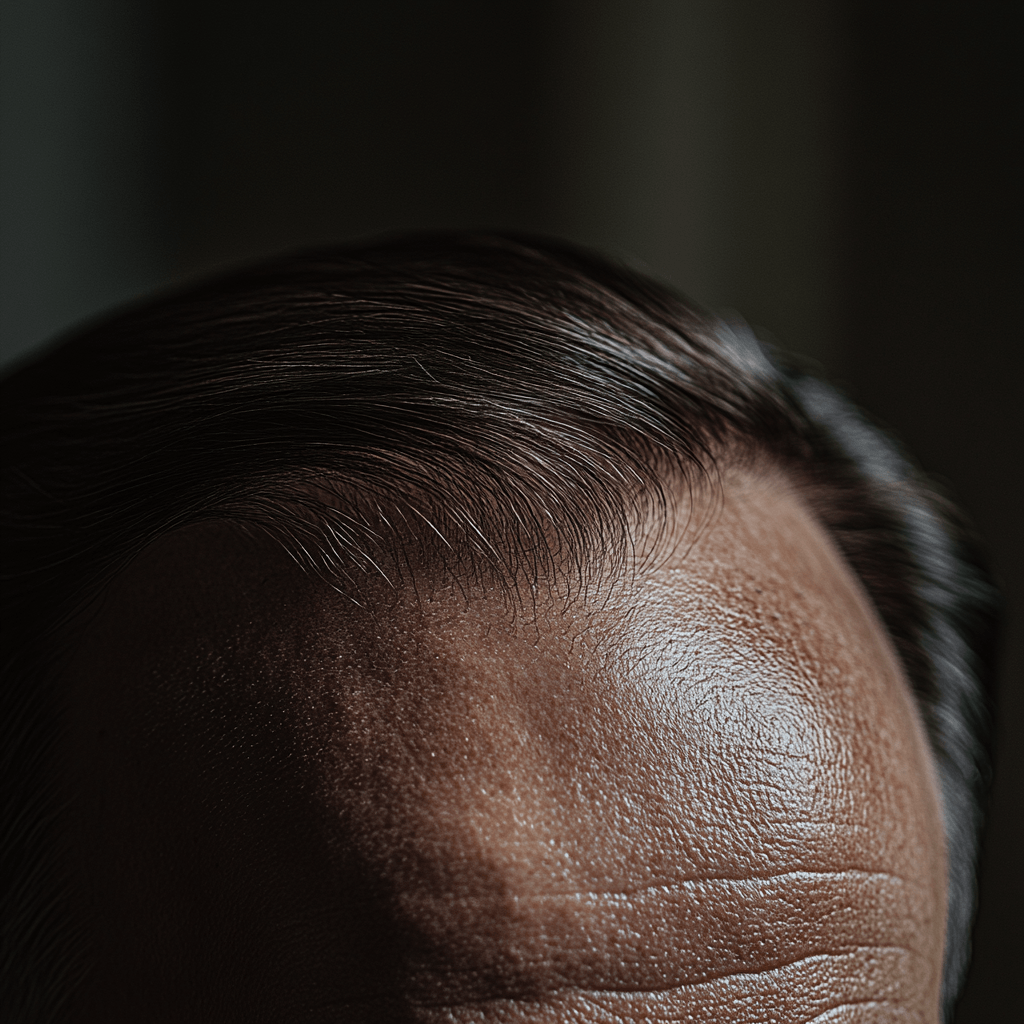
Psychological and Emotional Benefits
Beyond the physical improvements, hair implant surgery offers profound psychological and emotional benefits. Restoring hair can dramatically boost self-esteem and confidence, impacting personal, social, and professional interactions. The sense of renewal and positivity that comes from reclaiming control over one’s appearance often leads to significant improvements in overall mental health and well-being, helping individuals to feel more comfortable and confident in their skin.
How Do You Choose the Right Surgeon in Colombia?
Choosing the right surgeon in Colombia for hair implant surgery takes careful research, especially with so many options available. If you’re considering a Hair Transplant in Bogota, Hair Transplant in Medellin, or a Hair Transplant in Cartagena, there are a few key factors to keep in mind.
First, check the surgeon’s qualifications and certifications to ensure they are recognized by reputable medical boards. Experience is crucial—look for a specialist in hair restoration with a strong track record of successful procedures.
Reviewing before-and-after photos from previous patients can give you a clear idea of their work, and reading patient testimonials can provide insight into overall satisfaction. A good surgeon should also be open to answering your questions, explaining the procedure, recovery process, and expected results in detail.
Colombia has become a top destination for hair transplants, with modern clinics and highly skilled professionals. Whether you’re looking for a Hair Transplant in Bogota, Hair Transplant in Medellin, or Hair Transplant in Cartagena, thorough research and direct consultations will help you find the best option for your needs.
Importance of Certification and Experience
When selecting a surgeon for hair implant surgery in Colombia, the importance of certification and experience cannot be overstated. Certification ensures that the surgeon has met rigorous standards set by professional medical boards, indicating a foundational level of competency and adherence to industry best practices. Experience, on the other hand, offers assurance of the surgeon’s capability to handle a variety of cases with finesse and to anticipate and manage any complications effectively.
Together, certification and experience provide a dual layer of security, ensuring that you are entrusting your care to a surgeon who is not only qualified but also well-versed in the nuances of hair restoration procedures. This combination significantly impacts the surgery’s success and your satisfaction with the results.
How Is Hair Implant Surgery Performed in Colombia?
In Colombia, hair implant surgery is performed using state-of-the-art techniques that ensure both efficacy and patient comfort. The process begins with a detailed pre-operative assessment to design a personalized treatment plan. Surgeons in Colombia typically utilize two main methods: Follicular Unit Extraction (FUE) and Follicular Unit Transplantation (FUT).
FUE involves extracting individual hair follicles from the donor area and implanting them into the balding regions, minimizing scarring and reducing recovery time. FUT, on the other hand, involves removing a strip of skin with hair follicles from the donor area, which is then dissected into individual grafts and transplanted. Both procedures are conducted under local anesthesia, enhancing patient comfort.
Post-operative care is meticulously outlined by the medical team to ensure optimal healing and hair growth results. The combination of skilled surgeons, advanced techniques, and comprehensive care protocols positions Colombia as a leading destination for high-quality hair implant surgery.
Pre-Operative Assessments for Hair Implants
Before undergoing hair implant surgery in Colombia, patients undergo comprehensive pre-operative assessments. These evaluations are crucial for tailoring the surgery to the individual’s specific needs, considering factors like hair density, loss pattern, and overall health. This step ensures the selection of the most suitable hair implant technique for optimal results.
Primary Types of Hair Implant Techniques
In Colombia, two primary hair implant techniques are predominantly used: Follicular Unit Extraction (FUE) and Follicular Unit Transplantation (FUT). FUE is a minimally invasive method where individual follicles are extracted and transplanted, ideal for those seeking minimal recovery time. FUT involves removing a strip of hair-bearing skin from the donor area, then grafting it onto the balding sections, suited for extensive hair loss.
Anesthesia Options
Hair implant surgeries in Colombia are performed under local anesthesia, ensuring patients experience minimal discomfort during the procedure. Some cases may also utilize sedation to help with relaxation. The choice of anesthesia is determined based on the patient’s health, preferences, and the complexity of the procedure.
Step-by-Step Process of Hair Implant Surgery
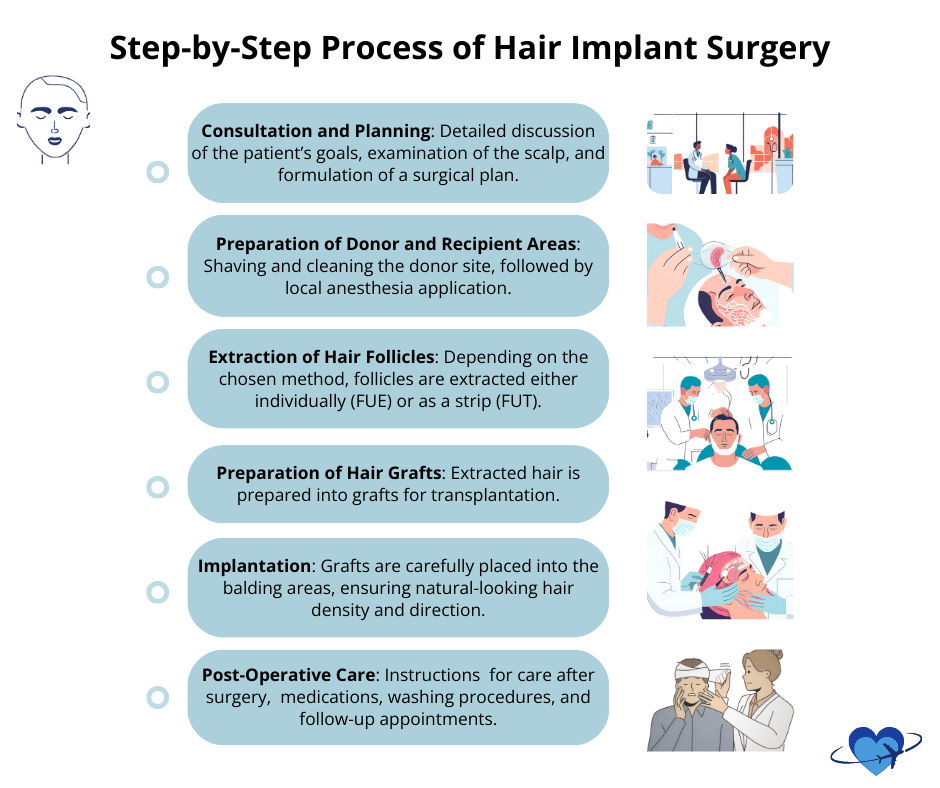
- Consultation and Planning: Detailed discussion of the patient’s goals, examination of the scalp, and formulation of a surgical plan.
- Preparation of Donor and Recipient Areas: Shaving and cleaning the donor site, followed by local anesthesia application.
- Extraction of Hair Follicles: Depending on the chosen method, follicles are extracted either individually (FUE) or as a strip (FUT).
- Preparation of Hair Grafts: Extracted hair is prepared into grafts for transplantation.
- Implantation: Grafts are carefully placed into the balding areas, ensuring natural-looking hair density and direction.
- Post-Operative Care: Instructions are given for care after surgery, including medications, washing procedures, and follow-up appointments.
What are the techniques Used in Hair Transplantation Surgery?
Techniques in hair transplantation focus on relocating hair follicles to revive balding areas. These strategies aim to restore hair density and craft a natural hairline. Follicular Unit Transplantation (FUT) requires excising scalp tissue, which is divided into smaller grafts for placement in thinning regions. Follicular Unit Extraction (FUE) employs precision small incisions to isolate individual follicles, eliminating the need for sutures. Direct Hair Implantation (DHI) utilizes a specialized tool to directly implant follicles, foreclosing incisions or sutures. An adjunct to FUE, the ARTAS robotic system, enhances follicle selection and extraction through computerized assistance.
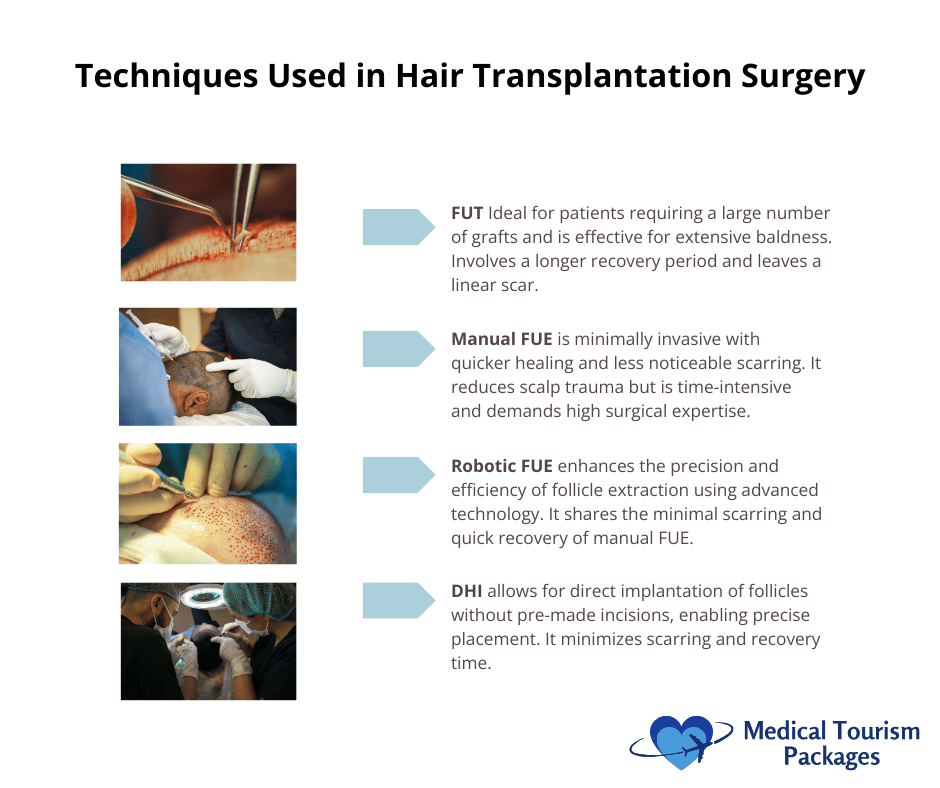
What is Manual FUE (Follicular Unit Extraction) technique?
Manual FUE stands as a cornerstone technique in hair transplant surgery. It intricately extracts individual follicular units with a specialized device. Local anesthesia ensures patient comfort, and the operation generally causes minor pain, with manageable post-procedure discomfort. Small, under 1 mm incisions characterize this minimally invasive route, promoting faster healing. Manual FUE excels in reducing scalp trauma and pain, thus hastening recovery. Importantly, it delivers natural, dense hair by meticulous follicle placement.
What is the Robotic FUE technique?
Robotic FUE, spearheaded by the ARTAS system, revolutionizes Follicular Unit Extraction with precision technology. This advanced method enhances extraction efficiency and safety, fostering superior hair transplant results. Robotic assistance reduces patient discomfort, streamlines time spent, and may decrease the chances of scarring. The prominence of Robotic FUE springs from its efficacy in achieving natural results with minimal downtime, a testament to its cutting-edge approach.
What is the FUT (Follicular Unit Transplantation) technique?
FUT, recognized as Follicular Unit Transplantation, involves removing a scalp strip to harvest follicular units. This traditional technique is invaluable for treating extensive baldness, offering plenty of grafts for hair revival. Recovery from FUT may extend for weeks, surpassing the swift recuperation associated with FUE. In the FUT process, the strip is dissected into individual grafts for implantation. While effective, FUT tends to leave more significant scarring due to the removal of a skin portion from the donor site.
What Is the Recovery Process for Hair Implant Surgery?
The recovery process for hair implant surgery is characterized by a well-defined timeline that ensures optimal healing and hair growth. Initially, patients may experience mild swelling, discomfort, and scabbing around the treated areas, which typically subside within the first week. It’s crucial to follow the post-operative care instructions provided by the surgeon, including medications for pain and antibiotics to prevent infection.
Patients are advised to avoid strenuous activities and direct sunlight exposure to the scalp for a few weeks post-surgery. Hair washing can usually resume a few days after the procedure, with specific guidelines on how to do so gently to protect the grafts. New hair growth can be expected within three to four months, with the full results becoming apparent after six to twelve months.
Throughout the recovery period, regular follow-up appointments are essential to monitor progress and address any concerns. This structured recovery process, coupled with adherence to care instructions, plays a pivotal role in achieving the desired aesthetic outcomes of hair implant surgery.
Immediate Post-Operative Care
After hair implant surgery, immediate post-operative care is crucial for ensuring a smooth recovery. Patients are typically provided with a set of detailed instructions that include how to care for the treated area, medications to take to reduce the risk of infection and manage pain, and tips on sleeping positions to avoid pressure on the transplanted grafts. It’s also important to keep the scalp dry and protected from direct sunlight and contaminants to facilitate proper healing.
Expected Recovery Timeline
The recovery timeline following hair implant surgery can vary, but generally, patients can expect mild swelling and discomfort to subside within the first few days. Scabbing around the transplant sites is common and should resolve within a week. Most individuals can return to non-strenuous activities within a few days, but it’s advisable to avoid heavy lifting and vigorous exercise for at least a month.
Visible hair growth typically begins around three to four months post-surgery, with the full effects usually apparent after six to twelve months.
| Timeframe | Recovery Milestones |
|---|---|
| Day 1-7 | Mild swelling, discomfort, and scabbing. Patients should avoid strenuous activities. |
| Day 3-5 | Hair washing may resume with gentle care. |
| Week 2 | Most visible signs of the procedure fade; patients can return to non-strenuous work. |
| Month 1-3 | Patients should avoid direct sunlight exposure and wearing hats. |
| Month 3-4 | Initial signs of new hair growth. |
| Month 6-12 | Full results become visible, showcasing significant hair growth and density improvements. |
How Do You Manage Pain and Discomfort?
Pain and discomfort after hair implant surgery are usually mild and manageable with prescribed or over-the-counter pain medications. Following the surgeon’s instructions on medication is key to effective pain management. Additionally, applying ice packs to the swollen areas, avoiding touching or scratching the scalp, and keeping the head elevated can help reduce discomfort.
If pain persists or intensifies, it’s essential to contact the surgeon for further guidance.
What Are the Risks and Considerations?
While hair implant surgery in Colombia offers transformative results, it’s important to understand the potential risks and considerations. Common complications include minor swelling, bruising, and discomfort around the treated areas, which typically resolve within a few days to weeks. Infection and scarring are rare but possible risks that can be minimized with proper post-operative care and by choosing an experienced surgeon.
Patients should also consider the possibility of temporary hair shedding, known as shock loss, which is a normal part of the recovery process and not indicative of the final outcome. Understanding these risks and maintaining realistic expectations about the growth timeline and the natural appearance of the transplanted hair are crucial for a satisfactory experience. Consulting with a qualified surgeon to discuss these considerations in detail is an essential step before proceeding with the procedure.
Common Complications for Hair Implants
While hair implant surgery in Colombia offers transformative results, it’s important to understand the potential risks and considerations. Common complications include minor swelling, bruising, and discomfort around the treated areas, which typically resolve within a few days to weeks. Infection and scarring are rare but possible risks that can be minimized with proper post-operative care and by choosing an experienced surgeon.
There is also the possibility of temporary hair shedding, known as shock loss, which is a normal part of the recovery process and not indicative of the final outcome. Understanding these risks and maintaining realistic expectations about the growth timeline and the natural appearance of the transplanted hair are crucial for a satisfactory experience. Consulting with a qualified surgeon to discuss these considerations in detail is an essential step before proceeding with the procedure.
| Complication | Description | Management | Prevention |
|---|---|---|---|
| Swelling | Common around the forehead and eyes, usually subsides within a few days. | Elevate the head; apply cold compresses. | Pre-operative medication as advised by the surgeon. |
| Bruising | Can occur around the treated areas. | Generally resolves on its own within a week. | Minimal handling and careful technique during surgery. |
| Discomfort | Mild to moderate pain post-surgery. | Pain relief medications as prescribed. | Proper surgical technique and post-operative care. |
| Infection | Rare but possible, indicated by redness, swelling, and discomfort. | Antibiotics and proper wound care. | Sterile technique and post-operative antibiotics if prescribed. |
| Scarring | Depends on the technique used (FUE scars are minimal). | Scar management treatments if necessary. | Choosing an experienced surgeon and following post-operative care instructions. |
| Shock Loss | Temporary shedding of transplanted or surrounding hair. | Usually resolves within a few months as new growth begins. | Educating the patient on the normalcy of this process. |
Factors Affecting Hair Implant Surgery Success
The success of hair implant surgery is influenced by several key factors. The quality of the donor hair and the technique used by the surgeon are paramount. The patient’s age, health status, and lifestyle also play crucial roles in the outcome.
Post-operative care, including following the surgeon’s instructions for scalp care and avoiding certain activities, is essential for optimal healing and hair growth. Finally, realistic expectations and a clear understanding of the procedure’s limitations are critical for patient satisfaction.
| Factor | Description | Impact |
|---|---|---|
| Quality of Donor Hair | Density and quality of hair at the donor site. | Determines the coverage and natural look of the transplant. |
| Technique Used | FUE vs. FUT, skill level of the surgeon. | Influences scarring, recovery time, and overall results. |
| Patient’s Age | Younger patients may experience progressive hair loss. | May affect long-term satisfaction and the need for future procedures. |
| Health Status | Underlying health conditions can affect healing. | Optimal health status can lead to better outcomes. |
| Lifestyle | Smoking, alcohol consumption, and diet. | Can impact healing and the longevity of the transplant. |
| Post-Operative Care | Following the surgeon’s care instructions. | Essential for optimal healing and growth of transplanted hair. |
| Local Climate | Exposure to sun and environmental factors. | Patients are advised to protect the scalp to ensure the best results. |
| Realistic Expectations | Understanding the procedure’s limitations. | Leads to higher patient satisfaction. |
By considering these factors and potential complications, patients can better prepare for their hair implant journey in Colombia, ensuring they make informed decisions and take necessary precautions for the best possible outcomes.
What Results Can You Expect from Hair Implant Surgery?
From hair implant surgery, patients can anticipate significant improvements in hair density and coverage in areas affected by thinning or baldness. Initially, transplanted hair may shed within a few weeks post-surgery, a normal part of the process allowing for new growth. True and lasting results become visible within three to six months as new hair begins to grow, with the most noticeable changes often observed after six to twelve months.
The final outcome is a natural-looking hairline and fuller hair, designed to be permanent with proper care. However, it’s important to maintain realistic expectations, as results vary based on individual characteristics like hair texture, density, and the nature of hair loss. Regular follow-ups with the surgeon can help manage expectations and monitor progress.
Aesthetic Improvements
Hair implant surgery leads to significant aesthetic improvements. Patients notice a fuller head of hair and a more youthful appearance, as bald spots are covered and hairlines are restored or enhanced. These changes are not just visible but also designed to be permanent, blending seamlessly with the patient’s natural hair growth patterns.
The improvements in appearance can dramatically alter how patients view themselves and are perceived by others, contributing to a more positive self-image.
Psychological and Emotional Benefits
Beyond the physical transformation, hair implant surgery offers profound psychological and emotional benefits. The restoration of hair can lead to increased self-esteem and confidence, significantly impacting an individual’s social interactions and professional opportunities. Many patients report feeling more vibrant and rejuvenated, experiencing a psychological uplift that enhances their overall quality of life.
These benefits underscore the holistic impact of hair restoration, affecting both the outer appearance and inner well-being.
How Do You Prepare for Surgery?
Preparing for hair implant surgery involves several key steps to ensure the best possible outcome. Initially, a consultation with your surgeon will help outline the procedure, set realistic expectations, and address any pre-existing health conditions that could affect surgery or recovery. Medical tests, such as blood work, might be required to assess your suitability for the procedure.
Patients are advised to avoid smoking and alcohol consumption for at least a week before the surgery, as these can impair healing. Additionally, certain medications and supplements that can increase bleeding, such as aspirin and ibuprofen, should be discontinued. Preparing your home for a comfortable recovery, including arranging for assistance if needed and stocking up on essential supplies, is also recommended.
What Medical Tests Are Required?
Before undergoing hair implant surgery, certain medical tests are essential to ensure patient safety and procedure suitability. These typically include blood tests to check for conditions that might complicate surgery or recovery. In some cases, a scalp analysis is also conducted to assess hair density and loss patterns, aiding in the creation of a tailored surgical plan.
What Lifestyle Adjustments Are Necessary?
Patients planning for hair implant surgery are advised to make several lifestyle adjustments. This includes quitting smoking and avoiding alcohol at least a week before the procedure, as these can affect wound healing and blood flow. Additionally, reducing exposure to direct sunlight and avoiding strenuous exercises that might increase scalp sweating is recommended in the days leading up to the surgery.
What Are the Pre-Operative Instructions?
Pre-operative instructions play a vital role in preparing for hair implant surgery. Patients are typically advised to stop taking medications and supplements that could increase bleeding, such as aspirin, ibuprofen, and certain vitamins, a week before the procedure. It’s also important to wash the hair with a prescribed antibacterial shampoo the day before surgery.
Ensuring a good night’s sleep and arranging for transportation to and from the clinic are also key steps in the pre-operative preparation.
How Much Does Hair Implant Surgery Cost in Colombia?
The cost of hair transplants in Colombia varies based on the number of hair grafts a patient needs. For a procedure involving 3000 grafts, prices generally range from $3,500 to $5,000 USD. If a patient requires a more extensive transplant of 5000 grafts, the cost increases to between $4,000 and $8,000 USD. On a broader scale, hair transplant costs in Colombia can range from $2,000 for 2000 grafts up to $10,000 for 8000 grafts, contingent on the clinic’s reputation and the surgeons’ expertise. Colombians honor their destination for delivering high-quality hair transplants combining skilled surgeons and modern clinics with competitive costs.
Factors Affecting the Cost
The cost of hair implant surgery in Colombia is influenced by several key factors. The technique used, whether FUE or FUT, significantly impacts the price due to the differences in complexity and time requirements. The number of grafts needed to achieve the desired density also plays a crucial role in determining the overall cost.
The experience and reputation of the surgeon can affect pricing, with highly regarded professionals often commanding higher fees for their expertise. Location within Colombia can contribute to cost variations, as prices may differ from one city to another based on local demand and clinic overheads. Lastly, additional services, such as pre-operative assessments and post-operative care, can add to the total expense, making it important for patients to consider all aspects when budgeting for their procedure.
| Factor | Description | Impact on Cost |
|---|---|---|
| Technique Used | FUE (Follicular Unit Extraction) vs. FUT (Follicular Unit Transplantation). FUE is generally more expensive due to its labor-intensive nature. | FUE > FUT |
| Number of Grafts | The total cost is often calculated based on how many hair grafts you need, which is determined by the extent of baldness. | More grafts = Higher cost |
| Surgeon’s Experience and Reputation | Surgeons with a high success rate and extensive experience usually charge more for their expertise. | Higher expertise = Higher cost |
| Location within Colombia | Prices can vary between cities, with larger cities like Bogotá and Medellín potentially being more expensive due to higher demand and clinic overheads. | Larger cities > Smaller cities |
| Additional Services | Includes pre-operative assessments, post-operative care, accommodation, and transportation if offered as part of a package. | More services = Higher total cost |
How Do You Select a Surgeon in Colombia?
Selecting the right surgeon for hair implant surgery in Colombia involves careful consideration of several factors to ensure safety and satisfaction with the results. Qualifications and certifications are paramount; verify that the surgeon is accredited by reputable medical boards. Experience in hair restoration specifically, including the number of procedures performed and the success rate, is crucial to assess their expertise.
Before-and-after photos of previous patients can provide visual evidence of the surgeon’s skill and aesthetic approach. Patient reviews and testimonials offer insights into personal experiences, surgeon-patient communication, and overall satisfaction. Lastly, consider the language proficiency if you’re a non-Spanish speaker to ensure clear communication throughout the process.
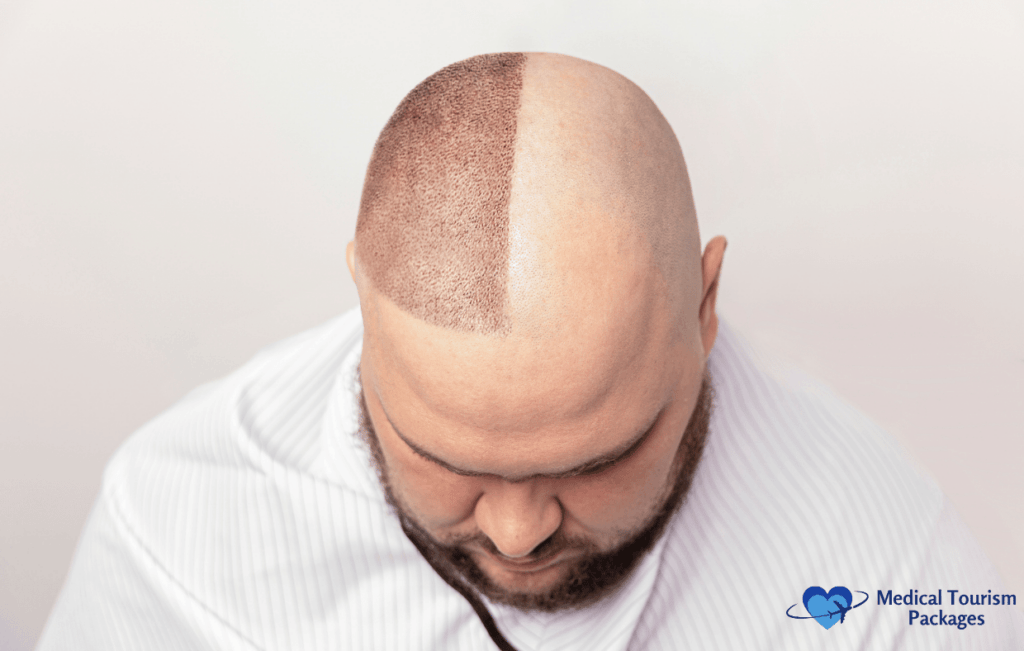
By evaluating these aspects, you can make an informed decision and select a surgeon in Colombia who meets your needs and expectations for hair implant surgery.
Checklist for Evaluating a Surgeon’s Qualifications and Experience
- Accreditation: Confirm that the surgeon is accredited by a reputable medical board or association, indicating adherence to high standards of practice.
- Specialization: Ensure the surgeon specializes in hair restoration surgery, with a focus on the latest techniques such as FUE and FUT.
- Years of Experience: Look for a surgeon with a substantial track record in performing hair implant surgeries, as experience often correlates with proficiency.
- Success Rate: Inquire about the surgeon’s success rate, seeking evidence of consistent, positive outcomes for patients.
- Patient Testimonials: Read or listen to testimonials from previous patients to gauge satisfaction levels and personal experiences.
- Before-and-After Gallery: Review the surgeon’s portfolio of before-and-after photos to assess aesthetic judgment and skill.
- Consultation Process: A thorough consultation process should be offered, where the surgeon evaluates your condition, discusses options, and sets realistic expectations.
- Ongoing Education: Check if the surgeon participates in continuous education to stay updated with advancements in hair restoration techniques.
- Communication Skills: Ensure the surgeon and their team have good communication skills, particularly if you require assistance in a language other than Spanish.
- Post-Operative Support: Verify that comprehensive post-operative care and support are available, including follow-up appointments and guidance for recovery.
This checklist is designed to help you assess and select a surgeon in Colombia who not only meets the required professional standards but also aligns with your specific needs and expectations for hair implant surgery.
Best locations for Hair transplant surgery in Colombia?
Colombia has several top destinations for hair transplant surgery, with Bogotá, Medellín, and Cartagena being the most popular choices. Hair Transplant Bogotá is sought after due to the city’s advanced medical infrastructure and highly trained specialists, often with international experience. Medellín, known for its modern healthcare facilities, has also become a hub for Hair Transplant Medellin, offering high-quality procedures at competitive prices. Meanwhile, Hair Transplant Cartagena appeals to those looking to combine their recovery with a relaxing coastal environment.
Each city has well-equipped clinics specializing in FUE (Follicular Unit Extraction) and FUT (Follicular Unit Transplantation) techniques. The choice of location often depends on personal preference, travel convenience, and the type of post-surgery environment desired. Bogotá and Medellín offer a more urban setting with access to top medical professionals, while Cartagena provides a more relaxed atmosphere for recovery.
Is Colombia good for hair transplant surgery?
Yes, Colombia is a great destination for hair transplant surgery, offering high-quality procedures at lower costs than in many other countries. Cities like Bogotá, Medellín, and Cartagena have modern clinics, experienced specialists, and advanced techniques like FUE and FUT, making it a popular choice for both locals and international patients.
How Do You Travel to Colombia for Surgery?
Traveling to Colombia for surgery involves a series of steps to ensure a smooth and safe journey. Initially, research and select a reputable clinic and surgeon, then schedule your surgery, allowing ample time for recovery before returning home. Verify travel requirements, such as passports or visas, and check if any vaccinations are recommended.
Booking flights and accommodations well in advance can secure better rates and ensure your stay is comfortable and convenient to the clinic. Consider travel insurance that covers medical procedures abroad for added security. Upon arrival, it’s advisable to have arranged transportation from the airport to your accommodation.
Familiarize yourself with local emergency numbers and the location of your country’s embassy or consulate. Lastly, plan for a relaxed stay in Colombia, allowing time for both pre-surgical consultations and post-operative care, making the most of your medical tourism experience.
Frequently Asked Questions About Hair Implants in Colombia
How Much Does Hair Implant Surgery Cost in Colombia?
The cost of hair implant surgery in Colombia varies widely but is notably more affordable than in many Western countries. Prices depend on the technique used, the number of grafts needed, and the surgeon’s expertise. On average, patients can expect to save significantly while still receiving high-quality care.
What Cosmetic Procedures Is Colombia Known For?
Colombia is internationally recognized for its expertise in a range of cosmetic procedures, including but not limited to plastic surgery, dental enhancements, and weight loss surgeries. Its reputation for quality care at competitive prices attracts patients from all over the globe.
What Are the Qualifications of Surgeons Performing Hair Implants in Colombia?
Surgeons performing hair implants in Colombia are often highly qualified, with many holding certifications from international medical boards. They typically have extensive experience in hair restoration techniques and stay updated with the latest advancements in the field.
How Long Does Recovery from Hair Implant Surgery Take in Colombia?
Recovery times can vary, but most patients can resume normal activities within a week after surgery. The initial healing phase may last up to two weeks, with full results of the hair transplant becoming visible within six to twelve months.
What Are the Risks Associated with Undergoing Hair Implant Surgery in Colombia?
As with any surgical procedure, there are risks involved, including infection, unsatisfactory results, and complications related to anesthesia. However, choosing a reputable and experienced surgeon can significantly minimize these risks.
How Does the Cost of Hair Implants in Colombia Compare to Other Countries?
Colombia offers competitive hair transplant costs, typically ranging from $2,000 to $5,000. The variation in price depends on several factors: the amount of hair grafts needed, the surgeon’s level of experience, and the details of the chosen package. In comparison to other countries, these rates are economical.
Colombia is known for its advanced medical systems and highly skilled surgeons, drawing international patients seeking quality hair transplants. Top Colombian clinics often collaborate with Turkish counterparts, capitalizing on Turkey’s reputation as a leading destination for hair transplant procedures. Consequently, patients benefit from a blend of experienced surgeons and cutting-edge techniques.
What Should Patients Expect in Terms of Results from Hair Implant Surgery in Colombia?
Patients can expect to see natural-looking and long-lasting results from hair implant surgery in Colombia. While individual outcomes may vary, the overall goal is to achieve a fuller head of hair that enhances the patient’s appearance and confidence.

